Intel Core i7-11700K Review: Blasting Off with Rocket Lake
by Dr. Ian Cutress on March 5, 2021 4:30 PM EST- Posted in
- CPUs
- Intel
- 14nm
- Xe-LP
- Rocket Lake
- Cypress Cove
- i7-11700K
Gaming Tests: GTA 5
The highly anticipated iteration of the Grand Theft Auto franchise hit the shelves on April 14th 2015, with both AMD and NVIDIA to help optimize the title. At this point GTA V is super old, but still super useful as a benchmark – it is a complicated test with many features that modern titles today still struggle with. With rumors of a GTA 6 on the horizon, I hope Rockstar make that benchmark as easy to use as this one is.
GTA doesn’t provide graphical presets, but opens up the options to users and extends the boundaries by pushing even the hardest systems to the limit using Rockstar’s Advanced Game Engine under DirectX 11. Whether the user is flying high in the mountains with long draw distances or dealing with assorted trash in the city, when cranked up to maximum it creates stunning visuals but hard work for both the CPU and the GPU.
We are using the following settings:
- 720p Low, 1440p Low, 4K Low, 1080p Max
The in-game benchmark consists of five scenarios: four short panning shots with varying lighting and weather effects, and a fifth action sequence that lasts around 90 seconds. We use only the final part of the benchmark, which combines a flight scene in a jet followed by an inner city drive-by through several intersections followed by ramming a tanker that explodes, causing other cars to explode as well. This is a mix of distance rendering followed by a detailed near-rendering action sequence, and the title thankfully spits out frame time data. The benchmark can also be called from the command line, making it very easy to use.
There is one funny caveat with GTA. If the CPU is too slow, or has too few cores, the benchmark loads, but it doesn’t have enough time to put items in the correct position. As a result, for example when running our single core Sandy Bridge system, the jet ends up stuck at the middle of an intersection causing a traffic jam. Unfortunately this means the benchmark never ends, but still amusing.
| AnandTech | Low Resolution Low Quality |
Medium Resolution Low Quality |
High Resolution Low Quality |
Medium Resolution Max Quality |
| Average FPS |  |
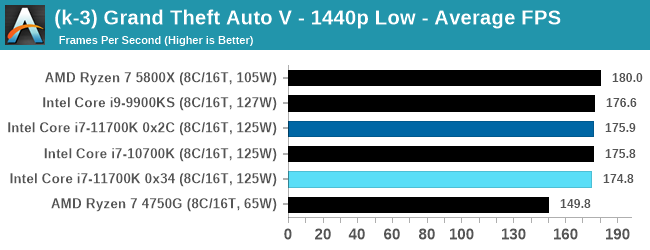 |
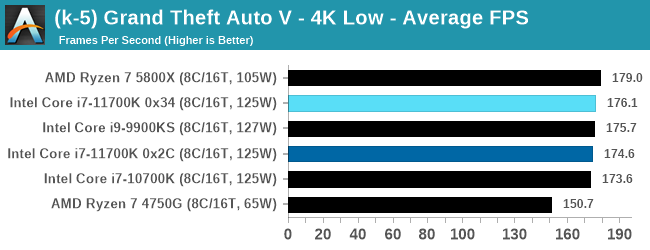 |
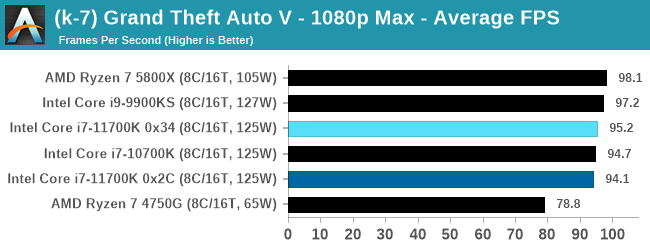 |
| 95th Percentile | 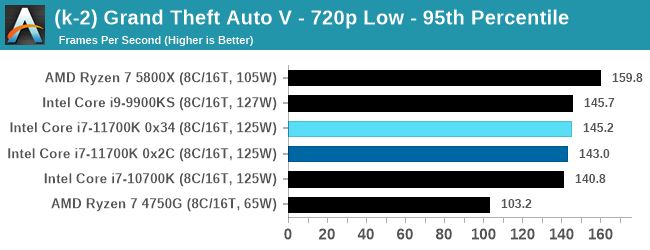 |
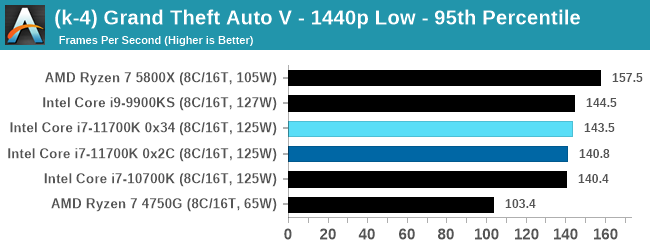 |
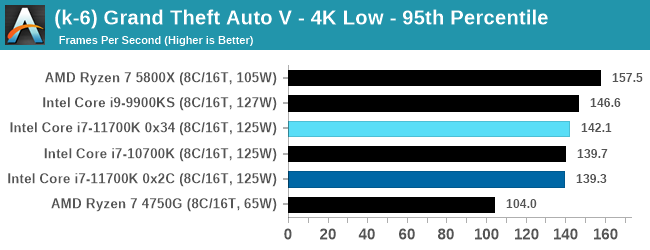 |
 |
All of our benchmark results can also be found in our benchmark engine, Bench.












541 Comments
View All Comments
TheinsanegamerN - Monday, March 8, 2021 - link
They're the same chip, the only difference is clock speeds. Dont get your hopes up, RKL is a total dud, much like Williamette was.Samus - Saturday, March 6, 2021 - link
blppt - my concern is that AMD may have a superior IPC, but the real fruit comes from the manufacturing process. Intel is still (somewhat) competitive at 14nm and that in itself is quite unbelievable. Imagine where this chip would be on 7nm or 10nm, at 6GHz+ and more cores with 2-3x the cache.That said, this victory may be short lived because AMD is basically taking advantage of the embarrassing execution Intel has repeated, much like they did 20 years ago with the P4 (albeit that was an architecture failure, not a manufacturing process failure)
Thesubtlesnake - Saturday, March 6, 2021 - link
Intel's latest 10nm process delivers *slower* clocks than its 14nm one. So, no, 6 GHz is not on the table. I imagine that when the transition to 7nm, Intel will be able to achieve moderately faster clock speeds than with 14nm.Otritus - Sunday, March 14, 2021 - link
10nm SF is good enough for 5 GHz. 10nm ESF can clock higher, so Intel's latest (but unreleased) process should match 14nm. I would not expect 7nm to clock higher than 14nm because it is becoming very clear that 5Ghz+ is just a waste of power and transistors, so i would not expect 7nm architectures to be designed to clock higher. We either are getting lots of IPC or just over 5GHz.Slash3 - Friday, March 5, 2021 - link
Mad lad.edved - Friday, March 5, 2021 - link
Nice write-up. Thank you.lucasdclopes - Friday, March 5, 2021 - link
Power efficiency is abysmal on this one.CiccioB - Friday, March 5, 2021 - link
No, it is not. It lower than AMD's efficiency, but it not that bad for being based on such an old process.PixyMisa - Friday, March 5, 2021 - link
So it's abysmal, but that's only to be expected?Spunjji - Saturday, March 6, 2021 - link
Not bad for an old process is still abysmal by the standards of 2021. No wonder Apple dropped them like a hot rock.